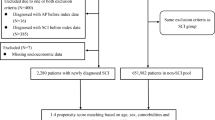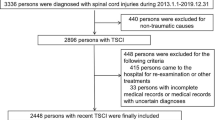Abstract
Study design
Retrospective cohort study.
Objectives
To assess the relative risk of osteoarthritis (OA) in individuals with newly diagnosed spinal cord injury (SCI) compared to a matched non-SCI group.
Setting
Taiwan’s Longitudinal Health Insurance Database.
Methods
We identified 1373 individuals aged 20–69 years with newly diagnosed SCI between 2002 and 2005 as the SCI group. A propensity-score-matched non-SCI group (N = 5492) with similar baseline demographic and clinical characteristics was selected for comparison. Both groups were followed until December 2011. OA-free survival was analyzed via Kaplan-Meier curves, and the association between SCI and OA risk was evaluated via stratified Cox proportional-hazards regression. To assess temporal risk variations, we performed landmark analysis with a 1-year cutoff, dividing follow-up into early (0–1 year) and long-term (≥1 year) periods.
Results
The respective incidence rates of OA for the SCI and non-SCI groups were 45.4 per 1000 person-years (95% confidence interval [CI], 40.1–50.1) and 31.6 per 1000 person-years (95% CI, 29.8–33.4). The hazard ratio of OA for the SCI group, as compared to the non-SCI group, was 1.52 (95% CI 1.34–1.72, p < 0.0001).
Conclusions
This population-based longitudinal follow-up study indicates that there is an increased long-term risk of OA in persons with SCI, underscoring the need for clinical vigilance and early diagnostic measures in this population. Further research is needed to explore the mechanisms underlying the association between these two conditions.
This is a preview of subscription content, access via your institution
Access options
Subscribe to this journal
Receive 12 print issues and online access
$259.00 per year
only $21.58 per issue
Buy this article
- Purchase on SpringerLink
- Instant access to full article PDF
Prices may be subject to local taxes which are calculated during checkout


Similar content being viewed by others
Data availability
The datasets used and/or analyzed during the current study are available from the corresponding author upon reasonable request.
References
Baker-LePain JC, Lane NE. Role of bone architecture and anatomy in osteoarthritis. Bone. 2012;51:197–203.
Frontera JE, Mollett P. Aging with spinal cord injury: an update. Phys Med Rehabil Clin N Am. 2017;28:821–8.
Lal S. Premature degenerative shoulder changes in spinal cord injury patients. Spinal Cord. 1998;36:186–9.
Morgenroth DC, Gellhorn AC, Suri P. Osteoarthritis in the disabled population: a mechanical perspective. PM R. 2012;4:S20–7.
Wylie EJ, Chakera TM. Degenerative joint abnormalities in patients with paraplegia of duration greater than 20 years. Paraplegia. 1988;26:101–6.
Arnet U, de Vries WH, Eriks-Hoogland I, Wisianowsky C, van der Woude LHV, Veeger DHEJ, et al. MRI evaluation of shoulder pathologies in wheelchair users with spinal cord injury and the relation to shoulder pain. J Spinal Cord Med. 2022;45:916–29.
de Oliveira RC, de Freitas LB, Gomes RR, Cliquet A. Orthopedic related comorbidities in spinal cord-injured individuals. Acta Ortop Bras. 2020;28:199–203.
Lo J, Chan L, Flynn S. A systematic review of the incidence, prevalence, costs, and activity and work limitations of amputation, osteoarthritis, rheumatoid arthritis, back pain, multiple sclerosis, spinal cord injury, stroke, and traumatic brain injury in the United States: a 2019 update. Arch Phys Med Rehabil. 2021;102:115–31.
Vanwanseele B, Eckstein F, Knecht H, Spaepen A, Stüssi E. Longitudinal analysis of cartilage atrophy in the knees of patients with spinal cord injury. Arthritis Rheum. 2003;48:3377–81.
Rodriguez G, Berri M, Lin P, Kamdar N, Mahmoudi E, Peterson MD. Musculoskeletal morbidity following spinal cord injury: a longitudinal cohort study of privately-insured beneficiaries. Bone. 2021;142:115700.
Lee YC, Huang YT, Tsai YW, Huang SM, Kuo KN, McKee M, et al. The impact of universal National Health Insurance on population health: the experience of Taiwan. BMC Health Serv Res. 2010;10:225.
Brookhart MA, Wyss R, Layton JB, Stürmer T. Propensity score methods for confounding control in nonexperimental research. Circ Cardiovasc Qual Outcomes. 2013;6:604–11.
Stang P, Lydick E, Silberman C, Kempel A, Keating ET. The prevalence of COPD: using smoking rates to estimate disease frequency in the general population. Chest. 2000;117:354s–9s.
Liu CY, Hung YT, Chuang YL, Chen YJ, Weng WS, Liu JS. Incorporating development stratification of Taiwan townships into sampling design of large scale health interview survey. J Health Manag. 2006;4:1–22.
D’Agostino RB Jr. Propensity score methods for bias reduction in the comparison of a treatment to a non-randomized control group. Stat Med. 1998;17:2265–81.
Wu CY, Chen YJ, Ho HJ, Hsu YC, Kuo KN, Wu MS, et al. Association between nucleoside analogues and risk of hepatitis B virus–related hepatocellular carcinoma recurrence following liver resection. Jama. 2012;308:1906–14.
Tonelli M, Wiebe N, Fortin M, Guthrie B, Hemmelgarn BR, James MT, et al. Methods for identifying 30 chronic conditions: application to administrative data. BMC Med Inform Decis Mak. 2015;15:31.
D’Agostino RB Jr. Propensity score methods for bias reduction in the comparison of a treatment to a non‐randomized control group. Stat. Med. 1998;17:2265–81.
Parsons LS. Performing a 1: N case-control match on propensity score. In: Proceedings of the 29th Annual SAS Users Group International Conference. SAS Institute; Quebec, Canada 2004.
Patel T, Milligan J, Lee J. Medication-related problems in individuals with spinal cord injury in a primary care-based clinic. J Spinal Cord Med. 2017;40:54–61.
Bae Y, Jung H, Shin N, Rahmati M, Udeh R, Kazemi A, et al. Musculoskeletal morbidity in adults with spinal cord injuries: a nationwide cohort study. NeuroRehabilitation. 2024;54:599–610.
Arokoski JP, Jurvelin JS, Väätäinen U, Helminen HJ. Normal and pathological adaptations of articular cartilage to joint loading. Scand J Med Sci Sports. 2000;10:186–98.
Vanwanseele B, Eckstein F, Knecht H, Stüssi E, Spaepen A. Knee cartilage of spinal cord-injured patients displays progressive thinning in the absence of normal joint loading and movement. Arthritis Rheum. 2002;46:2073–8.
Vincent TL, Wann AKT. Mechanoadaptation: articular cartilage through thick and thin. J Physiol. 2019;597:1271–81.
Kunz RI, Coradini JG, Silva LI, Bertolini GR, Brancalhão RM, Ribeiro LF. Effects of immobilization and remobilization on the ankle joint in Wistar rats. Braz J Med Biol Res. 2014;47:842–9.
Trudel G, Himori K, Uhthoff HK. Contrasting alterations of apposed and unapposed articular cartilage during joint contracture formation. Arch Phys Med Rehabil. 2005;86:90–7.
Nomura M, Sakitani N, Iwasawa H, Kohara Y, Takano S, Wakimoto Y, et al. Thinning of articular cartilage after joint unloading or immobilization. An experimental investigation of the pathogenesis in mice. Osteoarthritis Cartilage. 2017;25:727–36.
Salo PT, Seeratten RA, Erwin WM, Bray RC. Evidence for a neuropathic contribution to the development of spontaneous knee osteoarthrosis in a mouse model. Acta Orthop Scand. 2002;73:77–84.
Gater DR Jr, Farkas GJ, Berg AS, Castillo C. Prevalence of metabolic syndrome in veterans with spinal cord injury. J Spinal Cord Med. 2019;42:86–93.
Solinsky R, Betancourt L, Schmidt-Read M, Kupfer M, Owens M, Schwab JM, et al. Acute spinal cord injury is associated with prevalent cardiometabolic risk factors. Arch Phys Med Rehabil. 2022;103:696–701.
Zhuo Q, Yang W, Chen J, Wang Y. Metabolic syndrome meets osteoarthritis. Nat Rev Rheumatol. 2012;8:729–37.
Funding
This work was supported by grant MOST 109-2314-B-002-117 from the Ministry of Science and Technology, Executive Yuan, Republic of China, and Good Liver Foundation. However, the funders had no role in the study’s design, data collection, or analysis; the decision to publish it; or the preparation of the manuscript.
Author information
Authors and Affiliations
Contributions
CPL contributed to study design, data analysis, manuscript drafting, and revision. SLP contributed to study design, data analysis, manuscript drafting, and revision. All authors read and approved the final manuscript.
Corresponding author
Ethics declarations
Competing interests
The authors declare no competing interests.
Ethical approval
This study was approved by the Research Ethics Committee of National Taiwan University Hospital. The approval number is 201912207RIND. All methods were performed in accordance with the relevant institutional and governmental guidelines and regulations. All individuals’ data were encrypted to protect individual privacy and allow for anonymous analysis. Therefore, it obviated the need for informed consent as the database consists of de-identified data intended for research use.
Additional information
Publisher’s note Springer Nature remains neutral with regard to jurisdictional claims in published maps and institutional affiliations.
Rights and permissions
Springer Nature or its licensor (e.g. a society or other partner) holds exclusive rights to this article under a publishing agreement with the author(s) or other rightsholder(s); author self-archiving of the accepted manuscript version of this article is solely governed by the terms of such publishing agreement and applicable law.
About this article
Cite this article
Liu, CP., Pan, SL. Increased risk of osteoarthritis in persons with spinal cord injury: a population-based longitudinal follow-up study in Taiwan. Spinal Cord 63, 508–513 (2025). https://doi.org/10.1038/s41393-025-01112-x
Received:
Revised:
Accepted:
Published:
Issue date:
DOI: https://doi.org/10.1038/s41393-025-01112-x



